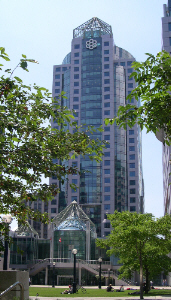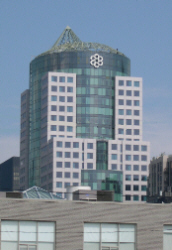Metro Hall was opened in November 1992 to serve as headquarters of the Municipality of Metropolitan Toronto. In 1988, Metro changed from a confederation of area municipal governments where councillors had been chosen from and by the councils of the area municipalities and had their offices in the local offices, to a clearly separate level of government with directly elected councillors. It was expedient that Metro Council have meeting space and councillor offices in the same building and away from any of the area municipality offices. Also it had been demonstrated that housing Metro staff, then scattered over many buildings, in one central headquarters would be more cost effective. Metro Hall was built with the latest in energy conservation measures and features to accommodate people with disabilities. The ground, second and third floors are public areas, while floors four to twenty seven house some City departments.

Metro Hall from east

from south

from Spadina
Since amalgamation in 1997, a number of proposals for sale of this apparently redundant building have been considered. It soon became abundantly clear that the new city could recapture only a small fraction of the original $220,000,000. capital cost and also that most of the space was required for the 2,300 city staff working there. While the idea of selling it still rises to the surface regularly, the opposing concerns still rule and it is still in use.
A Brief History of the Metro Government
In the twentieth century, it became obvious that local governments in and the Toronto area was highly fragmented and, with the spread of urban settlement into the rural area, could not cope with the challenges. The expansion and improvement of water and sewer systems, transportation networks and educational facilities and other urban services, were prime needs of the day. The existing government structure resulted in duplication of services, unequal distribution of wealth and varying levels of service delivery to area residents. A number of possible solutions were considered including annexation and amalgamation. but rejected. because the affected municipalities could not agree on the best form of reorganization. In January 1953 the Ontario Municipal Board, after studying the various proposals recommended the creation of a two-tier system of government for the area with shared responsibility for service delivery, the first such structure in North America.
On April 2, 1953, the Province of Ontario passed The Municipality of Metropolitan Toronto Act, establishing a federated system of government for the City of Toronto and its twelve surrounding municipalities (townships of York. Etobicoke, Scarborough, North York and East York, the towns of Weston, Mimico, New Toronto, Leaside; and the villages of Forest Hill, Swansea and Long Branch). Metro was given the responsibility for assessment, debenture borrowing, water supply and trunk mains, sewage treatment works and trunk sewers, and designated metropolitan roads. The municipalities retained their existing boundaries and continued to exercise a wide range of local responsibilities.
As Metro Toronto grew, its effectiveness was examined by several inquiries, studies and commissions and some changes were made In 1957, the local police forces were amalgamated into the Metro Toronto Police Force and the Metro Toronto & Region Conservation Authority was created to conserve the watershed, control the use of flood plains and develop recreational potential.
A major change, made in January l , 1961; was a consolidation of the original 13 municipalities into six: Toronto, North York. Scarborough, Etobicoke, York and East York. Welfare assistance was transferred to Metro. as were the responsibilities for traffic engineering and garbage disposal. School hoards wore merged to coincide with the six new municipal boundaries and the Metro Toronto School Board was given co-ordinating and financial control responsibilities. Metro Council was increased to 32 members, with the City of Toronto retaining 12 and the five suburban municipalities now sending 20 representatives because of their significant population growth since the establishment of Metro.
In 1974, Hon. John R, Robarts was asked to review the metropolitan Toronto system of government. He recommended that the six area municipalities be kept, with some boundary modifications, but that the Metro Council be directly elected and some changes in responsibilities. Others evaluated the various options and reaffirmed the need for more direct accountability. The new system was implemented in 1988. Metro Council was to have full-time politicians elected directly by the voters and the size of Metro Council reduced to 34 councillors. The Chair of Metro Council became an elected councillor. Directly elected councillors were able to give their undivided attention to major metropolitan issues such as Policing, transit and community services. Direct election helped the citizens’ understanding of which level was responsible for which service.
This level of government disappeared in 1997 with the amalgamation of all former municipalities into the present City of Toronto.
